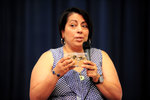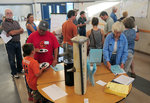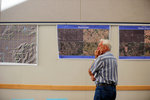



The Health Department and the Scatter Creek Aquifer Citizens Advisory group on Tuesday held a public workshop in the Rochester Middle School Commons to solicit community input regarding ways to keep water in the Scatter Creek Aquifer safe to drink now and in the future.
Organized by the Health Department and the Thurston County Board of Health, the citizens group has been meeting since last year to help evaluate the pollution risks to the aquifer under current land use and septic system regulations. The committee also has been tasked with creating a recommendation for future changes.
At Tuesday’s meeting, the citizens group and the government agencies asked for community input, a “recommendation to the board of health about what to do with Scatter Creek Aquifer, if anything,” Jane Mountjoy-Venning, the Thurston County Public Health liaison told the approximately 40 attendees.
Residents living in the Scatter Creek Aquifer area rely on groundwater for their drinking water, but water in this aquifer is highly vulnerable to contamination due to the sandy, gravelly soils, according to Mountjoy-Venning.
“The soil does not do a very good job of filtering out potential contaminants. In the not so distant past we have had problems with contamination — high nitrates, bacteria,” Mountjoy-Venning said.
Nitrates and bacteria are indicators that other contaminants — ones more difficult to test for — also can get in the water, she said.
Unlike other aquifers, Scatter Creek has only one level; it is a sole-source aquifer.
“Oftentimes aquifers are stacked one on top of the other like a layer cake,” Mountjoy-Venning said. “Here there’s just bedrock underneath. It’s like a bathtub filled with rocks and sand.”
“It’s the only source of water,” she went on. “If this one gets contaminated we can’t go deeper and look for another one.”
In previous years, the health department has applied for a number of grants, but none were approved.
But now, the county has secured funding from the Department of Ecology, and is able to move forward with the computer modeling and stakeholder and community outreach.
Nadine Romero, a geologist and hydrogeologist who is leading the modeling process, said she designed her model to incorporate data from a 24 square mile area, stretching from about 10 miles north of Rochester, to the outskirts of Tenino, to 5 miles south of Rochester, to the Lucky Eagle Casino.
Current condition data is deposited into a computer model, which processes the complex information and helps to formulate a prediction about future conditions.
Information collected during septic field assessments, for example, will — through the computer model — provide information about how much nitrate is coming out, and how fast it’s coming out, according to Nadine.
“Building a model helps us take the complexity and use it to create a prediction,” Romero said.
Suggested options for managing pollution from septic systems could include upgrading existing systems as well as establishing stricter standards for future septic systems, according to the Thurston County Public Health.
Community sewer service also could be used as a method of managing sewage disposal — however, sewers cannot be extended into the rural area under the state Growth Management Act.
“What the plan ultimately recommends will be the result of careful consideration of the scientific information and input from the community,” organizers of the project wrote on their website.
The project began in March 2012 and is slated to be completed by December 2014.
The land use risk analysis and computer modeling began in early 2013; the committee hopes to have a draft action plan ready by the end of 2013.
Committee members were appointed to the committee by the Board of Health and must live, own property, or work in the Scatter Creek Aquifer Area. The committee typically meets on the first Wednesday of the month at the Rochester School District Board Room; It began meeting in November 2012.
With input from Tuesday’s session, the citizens advisory committee will generate a list of options. Those plans will be presented to the public at a second community workshop, Mountjoy-Venning said.
If it ain’t broke, why should the government try to fix it, one local wondered on Tuesday.
The Rochester resident said the drinking water is excellent as it is and any project would be unnecessary and costly to taxpayers.
“This is going to cost of tens of thousands of dollars, and for what?” he asked.
The project is motivated more by money for the government than for ecological results, he added.
According to the Scatter Creek Aquifer team, the project could result in recommendations to change current land use or septic system regulations on private property.
Roger Max, a member of the citizens advisory group, acknowledged that, currently, water in the aquifer is clean and drinkable — and he wants to keep it that way.
“One of the big reasons I decided to settle here was the quality of the water,” the Olympia-Transit system driver said.
Maxis is not only concerned about the next generation, but about the generations upon generations to come.
“This is something that will affect us way, way down the road,” Max said. “You know how the Romans built their structures to last, with the future in mind? That’s how we need to be planning.”